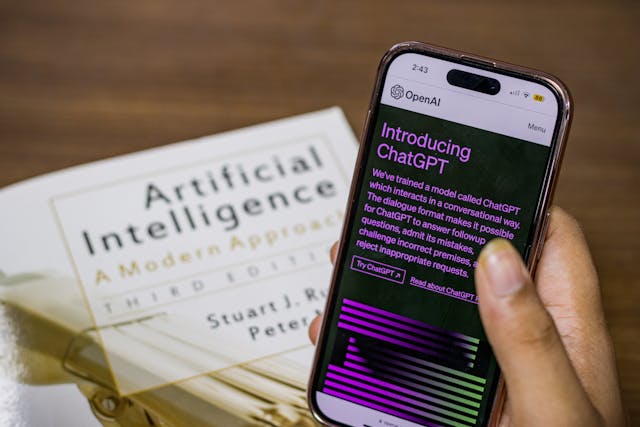
The Editing Company Inc.
Toronto, Ontario
Blog
RECENT POSTS
TEC Blog
Categories
Show All- Editing
- Grammar
- Usage
- Style
- Editor/writer
- Publishing
- Business
- Writing
- Writers support group
- Event
- Proofreading
- Copyright and permissions
- Usage
- Book reviews
- Editing new media
- Technology
- Books & libraries
- Ttc stories
- Editing & marketing
- Office happenings
- Social media & community
- Language & editing
- Social media
- Editing & marketing
- Indexing
- Book design
- Tec clients
- Guest blogger
- Creative women doing sixty
- Book clubs
- Books and reading
- Ebook technology & services
- Editing numbers
- Editing & technologies
- Opera, movies

What Is AI, Anyway?
by Lesley-Anne Longo
Published at 2024-03-13
There’s no doubt that we’ve all heard of “AI,” or artificial intelligence—it’s been all over the news channels for a while now. But what is it exactly? What does it do? And how does it (or how will it) affect how we work and live? And as editors, how will it affect our work down the line?
Here at TEC, we’ve decided to take a deeper look at artificial intelligence to understand what it is from our perspective. We begin with asking what it is, followed by what it means for editors, what AI editing software programs are already in play, and how we can learn more to be prepared for this “brave new world.”
What Is It?
AI is technology that enables computers and machines to simulate human intelligence and problem-solving or decision-making capabilities. This technology can function on its own, or be combined with other technologies, such as robotics or geolocation, to perform tasks that would otherwise require a human.
AI has been around us for a while and many of us may be using it without even realizing it. It is in GPS guidance systems such as Google Maps, in digital assistants, or in automated chat functions on many websites.
Two disciplines that are often packaged together with AI are machine learning and deep learning. These involve the development of AI algorithms that are modelled after the way the human brain processes and makes decisions. These algorithms can learn from the data given to them to make increasingly accurate decisions or predictions as time passes.
In general, AI systems work by ingesting large amounts of training data, analyzing the data for correlations and patterns, and then using these patterns to make predictions—for example, a chatbot that is fed examples of text can learn to generate realistic exchanges with people and appear more lifelike in those exchanges. Similarly, an image recognition tool can learn to identify and describe objects by reviewing millions of example images.
We are pretty familiar with chatbots these days since they pop up on many websites we visit. TEC considered having one a few years back but decided against it.
How Is AI Used?
Two popular ways AI is used and applied in our daily lives are through customer service applications and speech recognition.
For customer service, online virtual agents and chatbots are replacing human agents when it comes to customer interactions. These chatbots answer frequently asked questions on topics such as shipping times or costs, or provide personalized advice, such as suggesting sizes for users based on sizing data provided by the customer.
In terms of speech recognition, if you have a Google Home or an Alexa, you’ve used AI. If you’ve dictated a text to Siri, you’ve used AI as well: computer speech recognition, or speech-to-text, uses AI to process human speech into a written format. Many cell phones and mobile devices incorporate speech recognition into their systems to conduct voice searches or provide more accessibility.
However, there are other ways that AI is used, ways in which it performs tasks as well as, or better than, humans.
For example, AI has proven to be just as good as, if not better than, doctors at diagnosing certain cancers, such as breast cancer and melanoma. In financial institutions, where large data sets routinely need to be analyzed, AI is often used to process applications for loans and even detect fraudulent activities.
And, of course, we’ve all heard about the advent of self-driving cars, which use AI to evaluate risks and activity in the car’s surroundings.
What’s the Big Deal?
Okay, so using AI in the form of Google Maps to get home faster is one thing, but what’s really turned the tides in the world of AI is something called generative AI tools, such as Open AI’s Chat GPT, which you may have heard of by now.
Generative AI refers to deep learning models that can take vast amounts of raw data and “learn” in order to generate statistically probable answers when prompted. This raw data could be the entirety of Wikipedia or the collected works of Andy Warhol, for example.
These types of generative technologies can do anything from generating a painting of a camel sipping a milkshake in the exact style of Monet, to generating a university-level essay on Monet himself—which, if a student were to pass off this writing as their own becomes a question of plagiarism. AI can be a great educational tool, but it needs to be used responsibly.
Similarly, while AI tools present a range of new functionality for businesses, such as the automated screening of résumés during the hiring process, the use of AI also raises ethical questions because, for better or worse, an AI system will reinforce what it has already learned.
This can be a big problem because machine learning algorithms, which are the frameworks to many of the most advanced AI tools, are only as smart as the data they are given in training. Because a human chooses what data is used to train an AI program, the potential for machine learning to recreate human bias becomes another concern.
AI can also be used for nefarious purposes too—just look at the proliferation of deepfake ads, videos, and news articles all over the internet. In a recent news story, TV chef Mary Berg, singer Michael Bublé, comedian Rick Mercer, and hockey star Sidney Crosby all had their names, images, footage, and even voices exploited to promote scammy investment and cryptocurrency schemes.
These deepfakes are created with AI, and some of them are getting so realistic that it’s difficult to tell what’s real and what’s not. This is bad when it’s trying to sell you on a crypto scheme, but imagine how much worse it could be if it is content that is deliberately created and weaponized to interfere with elections.
AI bots are also getting smarter to the walls we humans have put up to keep robots out. CAPTCHAs—those tests you have to pass for many websites when you login that involve identifying all the images with stoplights, or cars, or bridges, etc., in them—are on the verge of becoming useless as AI bots learn more and more about how to emulate human behaviours.
In the End…
Of course AI has the potential to do great things and help many people, but we must also remember that it can be used nefariously as well. The great minds of today are already at work on these matters, and politicians and lawmakers are working to draft bills and laws to protect people from the ways AI technology can be weaponized.
But, in the end, it comes down to this: Can these increasingly “smart” machines outthink us? Or is human judgement always going to be necessary in making some of life’s most important decisions?
I believe that there are things about human experience that AI will never be able to replicate, for better or for worse, and that editors and writers will always have the advantage of being human thinkers rather than automated thinkers…at least for now!
Sources:
https://www.techtarget.com/searchenterpriseai/definition/AI-Artificial-Intelligence
https://cloud.google.com/learn/what-is-artificial-intelligence
https://www.ibm.com/topics/artificial-intelligence
Want a great editing tip in your inbox each month? Sign up for our enewsletter today!




